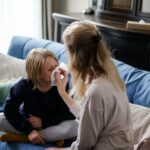 It’s that time of year again……. seasonal allergies!
It’s that time of year again……. seasonal allergies!
Seasonal allergies usually strike at the first signs of spring. This, however, also corresponds to lingering winter colds/illnesses. It can be tricky to figure out the difference.
What are the differences?
Right off, there are a few easy differences between seasonal allergies and common colds. One of the most significant is that a child will not develop a fever with seasonal allergies. In addition, most children with allergies exhibit a lingering runny nose that just never gets better as the days go by. One may see puffy eyes, sneezing, and coughing.
Most common colds run their course in about 7-10 days. Seasonal allergies can last much longer. Sometimes it can be tricky to figure this out, even for your pediatrician. It is best to seek guidance from your doctor if your child isn’t improving after a week.
Another general rule of seasonal allergies is that they rarely affect children under two years of age. There are some important behavioral and lifestyle changes if one does suspect allergies. The first would be to bathe your child every night. Pollen collects during the day on one’s clothes and hair. A nightly bath will rid the body of pollen so that your child is not sleeping in pollen all night. Secondly, it is most helpful to keep the inside environment as free from pollen as possible. It may seem discouraging to keep the windows shut on a breezy, beautiful spring day, but it will greatly benefit your child with allergies. Pollen counts tend to be highest in the morning and lowest after a soaking rain. Planning outdoor activities around these times (when able) may greatly benefit your child.
Your doctor, especially an allergist, can be most helpful in determining what environmental factors may or may not play a role. Depending on the severity of a child’s seasonal allergies, different medications may be helpful.
For more information regarding allergies and pollen please visit: CDC: allergens and pollen